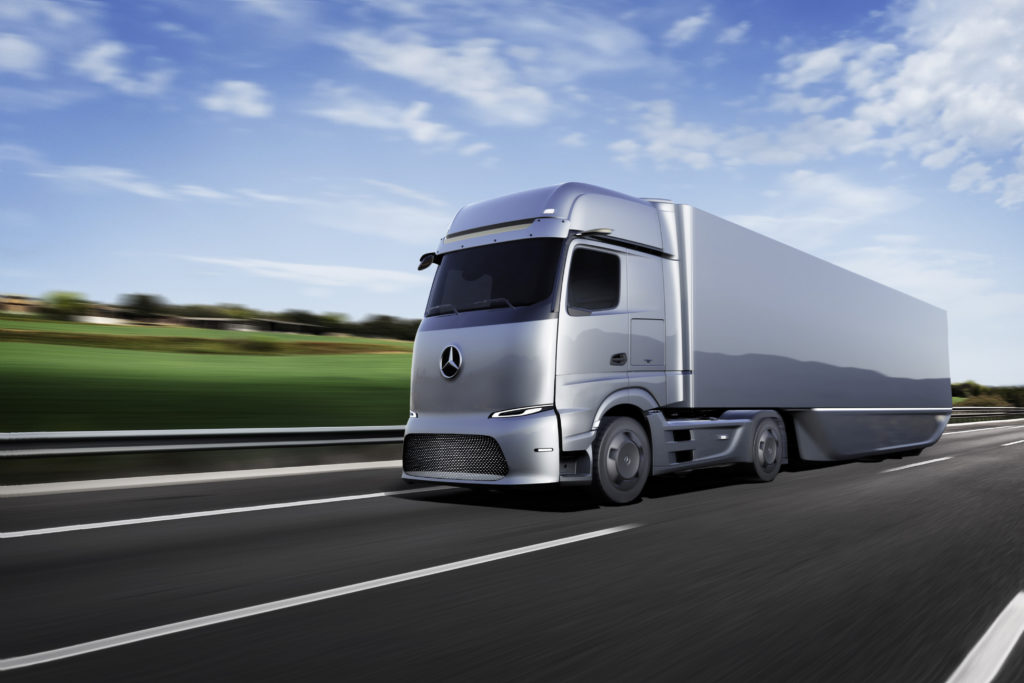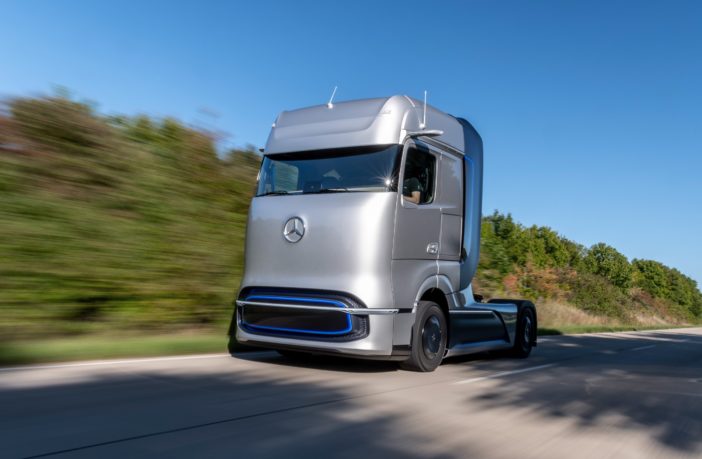Truck manufacturer Daimler Trucks has unveiled the future of its commercial vehicles by revealing two next-generation electric and hydrogen trucks.
As part of its technology strategy for the electrification of its vehicles, ranging from urban distribution to international long-haul transport, it first presented its Mercedes-Benz GenH2 Truck, which marks the beginning of fuel-cell drive.
With the GenH2 Truck, Daimler Trucks is demonstrating for the first time which specific technologies the manufacturer is driving forward at full speed so that heavy-duty fuel-cell trucks can perform flexible and demanding long-distance haulage operations with ranges of up to 1,000 kilometers and more on a single tank of hydrogen. Daimler Trucks plans to begin customer trials of the GenH2 Truck in 2023; series production is to start in the second half of the decade. Thanks to the use of liquid instead of gaseous hydrogen with its higher energy density, the vehicle’s performance is planned to equal that of a comparable conventional diesel truck.

Daimler Trucks also presented for the first time a preview of a purely battery-powered long-haul truck, the Mercedes-Benz eActros LongHaul, which is designed to cover regular journeys on plannable routes in an energy-efficient manner. Daimler Trucks plans to have the eActros LongHaul ready for series production in 2024. Its range on one battery charge will be approximately 500 kilometers. Additionally, with the Mercedes-Benz eActros for distribution transport, which was already presented in 2018 and has been tested intensively since then by customers in everyday transport operations, Daimler Trucks will start series production of a purely battery-powered heavy-duty truck next year. The range of the series-produced eActros on one battery charge will significantly exceed that of the prototype’s approximately 200 kilometers.
Daimler Trucks is pursuing similar vehicle schedules for the North American and Japanese markets as it is for Europe. By the year 2022, Daimler Trucks’ portfolio in its main sales regions – Europe, the USA and Japan – is to include series-produced vehicles with battery-electric drive. The company also has the ambition to offer only new vehicles that are CO2-neutral in driving operation (“from tank to wheel”) in Europe, North America and Japan by 2039.
As a new worldwide modular platform architecture, the so-called ePowertrain will be the technological basis of all medium- and heavy-duty CO2-neutral, all-electric series-produced trucks from Daimler Trucks – whether powered purely by batteries or by hydrogen-based fuel cells. It will feature high levels of performance, efficiency and durability. With the ePowertrain, Daimler Trucks plans to achieve synergies and economies of scale for all relevant vehicles and markets.
Martin Daum, Chairman of the Board of Management of Daimler Truck AG said:
“We are consistently pursuing our vision of CO2-neutral transport with a focus on the genuinely locally CO2-neutral technologies battery power and hydrogen-based fuel cells, which have the potential to succeed in the market in the long term. This combination enables us to offer our customers the best vehicle options, depending on the application. Battery power will be rather used for lower cargo weights and for shorter distances. Fuel-cell power will tend to be the preferred option for heavier loads and longer distances.”
The development engineers at Daimler Trucks have based the GenH2 Truck on the capabilities of the conventional Mercedes-Benz Actros long-haul truck with regard to tractive power, range, and performance. For example, the series-production version of the GenH2 Truck is to have a gross vehicle weight of 40 tons and a payload of 25 tons. Two special liquid-hydrogen tanks and a particularly powerful fuel-cell system will make this high payload and long range possible, and therefore form the core of the GenH2 Truck concept.
Daimler experts can draw on existing expertise for the development of liquid-hydrogen tanks, and they are also cooperating closely with a partner. With regard to fuel cells, the manufacturer benefits from its experts’ decades of experience, in terms of technology as well as production methods and processes. This represents an enormous advantage. In April this year, Daimler Truck AG concluded a preliminary, non-binding agreement with the Volvo Group to establish a new joint venture for the development to series maturity, production and commercialization of fuel-cell systems for use in heavy-duty commercial vehicles and other applications. Joining forces will decrease development costs for both companies and accelerate the market introduction of fuel cell systems. The joint venture is to benefit from the expertise of Daimler Truck AG and the Volvo Group. To facilitate the joint venture with the Volvo Group, Daimler Truck AG has brought together all Group-wide fuel-cell activities in the newly founded subsidiary Daimler Truck Fuel Cell GmbH & Co. KG.
Daimler Trucks prefers to use liquid hydrogen (LH2), because in this state, the energy carrier has a far higher energy density in relation to volume than gaseous hydrogen. As a result, the tanks of a fuel-cell truck using liquid hydrogen are much smaller and, due to the lower pressure, significantly lighter. This gives the trucks a larger cargo space and higher payload weight. At the same time, more hydrogen can be carried, which significantly increases the trucks’ range. This makes the series GenH2 Truck, like conventional diesel trucks, suitable for multi-day, difficult to plan long-haul transport and where the daily energy throughput is high.
Daimler Trucks is currently pressing ahead with the development of the necessary tank-system technologies to make liquid hydrogen usable also in mobile applications as an energy source for series-produced fuel-cell trucks. The storage of cryogenic liquid hydrogen at -253 degrees Celsius is already common practice in stationary applications, for example in industry or at hydrogen filling stations. This also applies to the transport of liquid hydrogen as cargo.
The two stainless-steel liquid-hydrogen tanks intended for the series version of the GenH2 Truck will have a particularly high storage capacity of 80 kilograms (40 kg each) for covering long distances. The stainless-steel tank system consists of two tubes, one within the other, that are connected to each other and vacuum-insulated. In the series version of the GenH2 Truck, the fuel-cell system is to supply 2 x150 kilowatts and the battery is to provide an additional 400 kW temporarily. At 70 kWh, the storage capacity of the battery is relatively low, as it is not intended to meet energy needs, but mainly to be switched on to provide situational power support for the fuel cell, for example during peak loads while accelerating or while driving uphill fully loaded. At the same time, the relatively light battery allows a higher payload. It is to be recharged in series-production vehicles with braking energy and excess fuel-cell energy. A core element of the sophisticated operating strategy of the fuel-cell and battery system is a cooling and heating system that keeps all components at the ideal operating temperature, thus ensuring maximum durability. In a pre-series version, the two electric motors are designed for a total of 2 x 230 kW continuous power and 2 x 330 kW maximum power. Torque is 2 x 1577 Nm and 2 x 2071 Nm respectively.
With its market launch in the middle of the decade, the eActros LongHaul will be available some time before the GenH2 Truck. The required infrastructure can also be set up sooner – and at comparatively low cost – by the transport companies themselves for charging at their depots. This so-called depot charging is the most important step for the use of the eActros LongHaul, and means that the first areas of application can already be covered. Another key component is opportunity charging for range extension, for example, while unloading or loading when the electric truck is anyway stationary. In the future, public charging at publicly accessible stations along main transport routes will also become increasingly important – a nationwide charging infrastructure will maximize the operating range of battery-electric trucks. New, more durable batteries will also contribute to the competitiveness of battery-electric trucks, reducing total cost of ownership over a vehicle’s lifecycle.
Source: https://www.electrichybridvehicletechnology.com
CUT COTS OF THE FLEET WITH OUR AUDIT PROGRAM
The audit is a key tool to know the overall status and provide the analysis, the assessment, the advice, the suggestions and the actions to take in order to cut costs and increase the efficiency and efficacy of the fleet. We propose the following fleet management audit.




